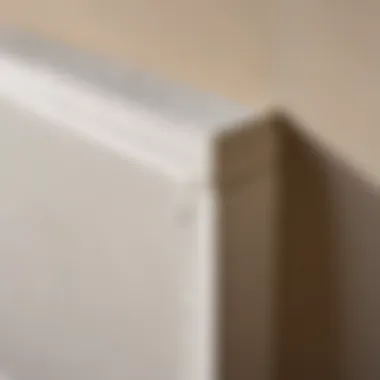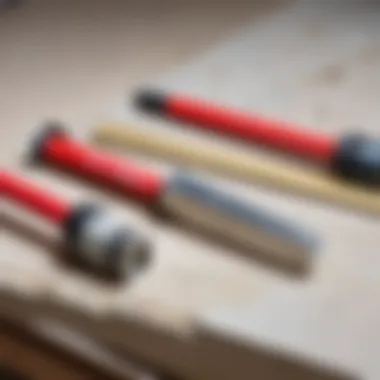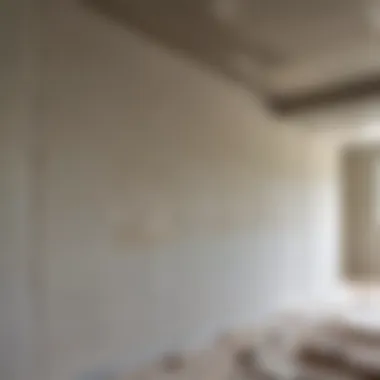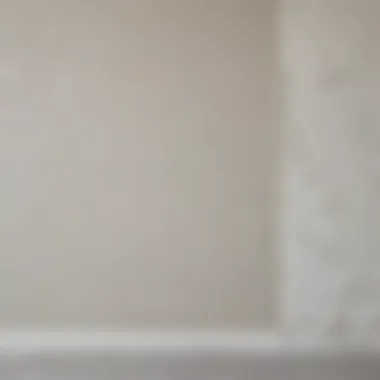Mastering the Drywall and Plaster Interface


Intro
In the realm of interior construction and design, the interaction between drywall and plaster demonstrates a unique set of challenges and advantages. Understanding these elements is key for anyone engaged in renovation or design projects. This article explores the dynamics at play when combining drywall and plaster, focusing on their material properties, compatibility issues, and effective installation practices.
Navigating this interface requires careful consideration of various factors. From material choices to preparation techniques, a well-informed approach can lead to a refined finish in your projects. This guide appeals to a wide range of readers, including DIY enthusiasts, interior designers, and builders keen on enhancing their expertise.”
Проектирование и планирование
Как выбрать проект для DIY
Choosing the right DIY project is paramount. Before pulling out tools, consider the goals. What is desired outcome? Is it purely aesthetic, or does it serve a functional purpose? Establishing clarity around the project's intentions informs all subsequent decisions.
When merging drywall and plaster, one must assess the space involved. Small areas may benefit from a straightforward approach, while larger spaces could demand a more nuanced strategy. Ensuring alignment with existing structural elements is crucial.
Оценка времени и ресурсов
Time and resources should be evaluated comprehensively. List all materials needed: drywall sheets, plaster, joint compound, and tools. Ensure sufficient quantities are on hand to prevent interruptions.
When estimating time, factor in each phase of installation. Preparation, application, and finishing can collectively take hours or days, depending on complexity. Allocating adequate time minimizes stress and allows for adjustments as needed.
Выбор материалов
Типы материалов для различных проектов
Selecting the proper materials is essential for success. Drywall typically comes in several types, such as standard, moisture-resistant, and fire-resistant. Each variant serves specific environments. For plaster, options include traditional lime plaster, gypsum plaster, and pre-mixed compounds. Understand the best fit for your project’s requirements to ensure long-lasting results.
Советы по покупке и экономии
Shopping efficiently can save both time and money. Consider local suppliers for materials. Often, bulk buying can lead to reduced costs. Additionally, keeping an eye on sales or clearance sections can provide significant savings.
Don't overlook online marketplaces for new or gently used tools and materials, which can help keep expenses in check. Make a detailed list before heading out to prevent impulse buys that could derail the budget.
"A solid project starts with a clear plan and the right materials"
Understanding Drywall and Plaster
The interface between drywall and plaster is crucial in construction and renovation. Understanding drywall and plaster allows for better integration and overall improved outcomes in building and repairing. The two materials have distinct characteristics that impact their performance and durability. Proper comprehension and application of these materials result in a stable and visually appealing finish.
Materials Overview
Composition of Drywall
Drywall, also known as gypsum board, consists mainly of gypsum sandwiched between two layers of heavy paper. Gypsum is a mineral that lends fire resistance and a lightweight quality to drywall. Its manufacturing process allows for easy installation and a smooth surface for finishing.
One key characteristic of drywall is its ease of handling. It is readily available in various thicknesses, allowing builders to choose the right type based on specific applications. This versatility supports a range of projects, from residential to commercial construction. Its installation requires minimal tools and can be accomplished in a relatively short time.
However, drywall also has its disadvantages. The surface can be susceptible to damage from moisture, which may lead to mold growth. Once compromised, repair can be costly and labor-intensive.
Composition of Plaster
Plaster is typically made from a mixture of water, sand, and a binding agent such as gypsum or lime. This combination provides a hard, durable surface. Plaster can be applied directly to masonry walls or used to create intricate designs and textures. Its adaptability makes it a favored choice among interior designers and builders.


A key feature of plaster is its aesthetic appeal. It can be molded to create decorative finishes that drywall cannot achieve easily. This unique characteristic allows for greater creativity in interior design. However, plaster takes longer to set than drywall, requiring more skill and patience during installation.
Additionally, plaster can be prone to cracking over time, particularly in areas with temperature fluctuations. Understanding these attributes is important for ensuring long-lasting results when integrating plaster with drywall, especially in high-stress environments.
Properties and Functions
Drywall Characteristics
In terms of properties, drywall possesses excellent sound-dampening qualities. Its density contributes to noise reduction, making it ideal for walls that require privacy, such as in apartments or offices. It is also fire-resistant, providing a protective barrier that enhances safety.
These characteristics make drywall a popular choice for interior applications. It can support a variety of finishes, including paint and wallpaper. However, its physical properties call for careful handling, especially during installation.
Plaster Characteristics
Plaster is known for its rigidity. Once dry, it becomes a strong protective layer that can withstand a fair amount of impact. However, this inherent strength comes with a caveat—plaster can crack if subjected to sudden shifts in structure or temperature.
The unique advantage of plaster lies in its textural capabilities. It can be intricately fashioned into various styles, from smooth and sleek to richly detailed and ornate. This versatility positions plaster as an excellent choice for transformative design overlays in spaces that demand elegance.
Overall, understanding the properties and functions of both drywall and plaster is essential. It ensures that one can make informed decisions in selecting materials based on project requirements and desired outcomes.
The Importance of Proper Joint Handling
Handling the junction between drywall and plaster requires careful attention. Each material has its own properties that can complicate joint integrity if not managed properly. It is crucial to emphasize this aspect because of the potential for structural issues and aesthetic degradation over time. This section aims to provide insight into the methods of effectively managing these junctions to ensure durability and visual appeal.
Identifying Stress Points
Common Problem Areas
Common problem areas typically occur where drywall and plaster meet. These junctions are susceptible to cracking and movement due to differences in material properties. One of the key characteristics is that plaster is more brittle and prone to cracking when stressed compared to drywall.
An advantage of identifying these areas early is that it enables proactive measures. For instance, corners and seams are frequently subject to stress from physical impacts or settling, making them prime candidates for reinforcement. Assessing these points systematically can lead to solutions that minimize damage in long-term scenarios.
Visual Indicators of Failure
Visual indicators of failure often manifest as cracking, flaking, or bulging at the joint. These symptoms can be subtle at first but may progressively worsen, indicating a larger issue. Recognizing these signs early can prevent more severe problems down the line.
One prominent characteristic is that cracks typically originate from the same stress points mentioned earlier. They act as early warning signals for potential structural failures. A unique feature of these indicators is that they can sometimes indicate moisture intrusion, adding another layer of complexity in assessing joint integrity. Ignoring such signs might lead to comprehensive damage, making early intervention vital.
Impact of Improper Integration
Structural Implications
Structural implications of improper integration between drywall and plaster are substantial. If the joint is not properly managed, it can lead to sagging, warping, or other structural failures over time. One key characteristic here is that combined loads on these materials can exceed their carrying capacities when not correctly aligned.
This problem is particularly evident in older buildings with historical plasterwork, where modern drywall application techniques may not align well. Thus, understanding these implications is beneficial for maintaining structural integrity.
Long-term Aesthetic Issues
Long-term aesthetic issues also arise from poor joint handling. Discoloration, cracks, or uneven surfaces can significantly detract from the visual appeal of a room. An important characteristic of aesthetic degradation is that it often becomes more pronounced with time, making these issues hard to remedy without extensive repairs.
One unique feature is that aesthetic concerns are often perceived by inhabitants long before structural failures occur. Hence, they serve as a crucial metric in determining the state of the joint. Maintaining a seamless integration not only preserves structural integrity but also enhances the overall look of the space.


Techniques for Seamless Integration
Achieving seamless integration between drywall and plaster is essential for aesthetic and functional purposes in construction and renovation. Proper techniques can drastically improve the durability of finished surfaces while also maintaining a pleasing appearance. Integration methods ensure that the surfaces not only bond well but also can withstand the everyday stresses without showing signs of wear or failure. Understanding the nuances behind these techniques contributes to successful installations and can prevent costly repairs in the future.
Preparation Steps
Surface Cleaning
Surface cleaning is a critical step before applying any joining materials between drywall and plaster. This process involves removing dust, dirt, and any old adhesive substances that may interfere with adhesion. The key characteristic lies in its ability to create a uniform substrate which allows for a better bond. A clean surface is not only essential but is often the most time-consuming part of preparation. Neglecting this step can lead to poor adhesion and subsequent detachment over time.
One beneficial aspect of surface cleaning is accessibility. The cleaning process can be easily performed using basic tools like a broom, vacuum, or damp cloth. However, it is important to note that using excessive water could potentially damage the drywall or plaster. A unique feature of this process is that it can also help identify existing imperfections that may need addressing prior to applying new materials. In this article, we recommend thorough surface cleaning to enhance the longevity and effectiveness of the integration process.
Material Compatibility Checks
Material compatibility checks focus on ensuring that the materials used in the integration of drywall and plaster are suitable to work together. This aspect is crucial as not all compounds bond effectively with each other. A key characteristic of this practice is its role in preventing future complications, such as cracking or peeling, which may arise from material incompatibility.
A popular benefit of conducting these checks is the peace of mind it delivers. It allows the practitioner to select appropriate materials that have been tested for the task at hand. Furthermore, a unique feature of compatibility checks is the opportunity to consider environmental factors that might influence the performance of selected materials. For instance, humidity levels can affect adhesive drying times. These aspects ensure a more stable finished product once completed, reducing the need for future maintenance efforts.
Application Methods
Joining Techniques
Joining techniques refer to the methods employed to bring drywall and plaster together. This contributes significantly to overall structural integrity and appearance. A key characteristic of these techniques is their versatility—different methods may be used depending on specific project requirements, such as the weight of plaster or the configuration of the joint.
These techniques are beneficial as they allow for various finishes to be achieved, catering to different aesthetic preferences or functional needs. For example, a simple butt joint may suffice for some applications, while others may require more elaborate overlaps or patterns. A unique feature of these joining methods is that they can facilitate an easier application of plaster, leading to a more refined end result. However, improper technique could jeopardize the overall quality, resulting in visible seams or future failures.
Appropriate Adhesives and Tools
The choice of appropriate adhesives and tools is vital in achieving a successful integration of drywall and plaster. The adhesives play a crucial role in securing the materials together, while the tools are essential for application and finishing. A key characteristic of quality adhesives is their formulation which needs to be evaluated to ensure compatibility with both drywall and plaster.
This selection process is beneficial as it directly impacts durability, ease of use, and finishing results. For example, using a high-quality joint compound supports better adhesion and reduces the risk of cracks appearing over time. Moreover, the unique feature of using specialized tools, like trowels and joint knives, allows for neat application and easier smoothing of seams. Incorporating appropriate materials and tools will result in a tighter, more professional finish, preventing potential rework in the future.
Finishing Touches
Finishing touches are essential in any construction or remodeling project involving drywall and plaster. This is the stage where the aesthetic quality meets functional integrity. Proper finishing ensures that the joint between drywall and plaster appears seamless and visually appealing. It involves smoothing surfaces, applying paint, and finishing textures that unify the wall’s appearance, making it more attractive and durable. Skipping or poorly executing this phase can result in visible imperfections, affecting not just the look, but also the longevity of the materials used.
Smoothing and Sanding
Determining Proper Techniques
Determining proper techniques for smoothing and sanding is critical for achieving a refined finish on drywall and plaster joints. Techniques like wet sanding or using a fine-grit sandpaper are recommended. This contributes to removing uneven areas while minimizing dust. A key characteristic of these techniques is their adaptability—they can be used effectively on various surfaces. This is particularly beneficial because it allows for fine adjustments, which can change the end result significantly. However, one disadvantage may be the time it takes to achieve perfection, as multiple rounds of sanding can be necessary.
Tools for Achieving a Smooth Finish
Tools for achieving a smooth finish play a vital role in the finishing phase. Commonly used tools include sanding blocks, orbital sanders, and pole sanders. The key characteristic of these tools is their effectiveness in creating an even texture across large areas, which can greatly enhance the final look of the wall. A unique feature of these tools is their ergonomic designs, which help reduce fatigue during use. The advantage lies in their ability to produce quickly smooth surfaces; however, a downside could be the initial learning curve involved in using power tools properly.
Painting and Texturing
Choosing the Right Paint
Choosing the right paint can significantly influence the overall aesthetics and longevity of drywall and plaster finishes. The proper paint forms a protective layer that resists moisture and stains, which is essential for prolonging the life of the underlying materials. A key characteristic of selecting appropriate paint is understanding its composition—water-based paints are usually recommended for easy cleanup and low VOC emissions. Unique features include the varied finishes available, from matte to gloss, which can create different effects on the wall surface. However, a disadvantage might stem from some paints requiring multiple coats for uniform coverage.


Application Techniques for Texture
Application techniques for texture are equally pivotal for enhancing the visual interest of walls. Techniques like rolling, spraying, and sponging allow for a diverse range of finishes. The key characteristic of these techniques is versatility—they can be tailored to the desired appearance, whether subtle or pronounced. One interesting feature of texture application is its potential to hide imperfections. This is advantageous, especially in older homes where walls may not be perfectly flat. However, a disadvantage is the additional time and skill necessary to master these techniques, which might deter some DIY enthusiasts.
Maintenance and Repairs
Maintenance and repairs are critical aspects of ensuring a long-lasting and visually appealing junction between drywall and plaster. The interface where these two materials meet is subject to various stresses that can lead to wear and tear over time. Proper maintenance prevents minor issues from escalating and maintains aesthetic quality. Regular inspections can identify problems early, minimizing costly fixes. This section will outline common maintenance issues and effective repair techniques, highlighting the importance of proactive care.
Common Maintenance Issues
Identifying Wear and Tear
Identifying wear and tear is essential in maintaining the integrity of drywall and plaster interfaces. Common signs include cracks, peeling paint, or discolored patches. These issues indicate that stress is affecting the joint connection. By observing these key characteristics, one can monitor the health of the installation. It is beneficial to address wear and tear quickly, as delaying repairs can lead to more extensive damage.
Key features of identifying wear and tear include regular inspections and visual assessments. This proactive approach helps in maintaining the aesthetic and structural integrity of the surfaces. While it requires some time and effort, it is a worthwhile choice in this context. Not addressing wear and tear early can result in higher repair costs and reduced life expectancy of the materials.
Preventative Measures
Preventative measures play a vital role in protecting the interface between drywall and plaster. Regular maintenance practices can help mitigate common issues before they arise. These measures may include applying sealants or proper ventilation to reduce moisture. This strategy emphasizes avoiding problems rather than fixing them after they occur.
Key characteristics of preventative measures include their cost-effectiveness and simplicity. Implementing them may require minor investments but can save time and money on major repairs later. Unique features include regular inspections and timely touch-ups of finishes, which can significantly prolong the life of the materials. The primary disadvantage here is that neglecting even small preventative measures can lead to bigger problems down the line.
Repair Techniques
Common Repair Procedures
Common repair procedures are necessary for addressing issues that arise in the drywall and plaster interface. Methods like patching cracks, applying joint compounds, and retexturing surfaces help restore the material's integrity. These procedures vary in complexity, making them accessible to both novice and experienced practitioners.
The key characteristic of these procedures is their adaptability. Different techniques can be used depending on the nature and extent of the damage. This flexibility makes common repair procedures a practical choice in maintaining both drywall and plaster. However, a potential downside is that some repairs may require specialized tools, which might not always be readily available.
Materials for Repair
Choosing the right materials for repair is crucial to ensure lasting results. Commonly used materials include joint compound, plaster repair patches, and sealants. These materials are specifically designed to adhere to both drywall and plaster, providing a strong bond.
The key characteristic of utilizing appropriate materials for repair reduces the likelihood of future issues. This makes it a beneficial aspect of the overall maintenance process. Unique features of these materials include their ease of application and quick drying times. However, using poor-quality materials can compromise the durability of repairs, making it critical to choose wisely.
"Effective maintenance and proper repair techniques not only enhance durability but also preserve the aesthetic appeal of spaces that combine drywall and plaster."
By prioritizing maintenance and employing effective repair techniques, one can ensure a durable and visually pleasing junction between drywall and plaster.
Epilogue
The concluding section of this article is integral in reinforcing the essential concepts discussed throughout the guide. It serves to summarize the complexities associated with integrating drywall and plaster. Understanding the nuances of these materials can significantly influence the longevity and aesthetic appeal of homeowner projects, particularly in residential renovations.
Summarizing Key Points
In review, the intersection of drywall and plaster involves various critical aspects:
- Material Compatibility: Knowing the compatibility between different types of drywall and plaster is vital. This avoids issues such as cracking or poor adhesion.
- Techniques for Integration: Proper joining techniques and the right tools can lead to seamless transitions between drywall and plaster.
- Maintenance Considerations: Keeping an eye on wear and tear is essential for maintaining the integrity of the interface over time.
- Common Issues: Recognizing common problems, like stress points and signs of failure, allows for timely repairs.
By focusing on these areas, individuals can more effectively execute their projects, reducing the risk of future complications.
Final Recommendations
When approaching projects involving drywall and plaster, keep certain recommendations in mind:
- Invest in Quality Materials: Choose high-quality drywall and plaster products. This may initially be more costly, but it pays off in durability and reduced maintenance.
- Follow Best Practices: Rely on proven techniques and adhere to guidelines during installation. This includes using appropriate adhesives and following careful application methods.
- Incorporate Maintenance Routines: Regular checks and maintenance can prolong the life of your drywall and plaster interface. Establish preventative measures early.
- Seek Professional Guidance if Needed: If the task feels overwhelming, do not hesitate to consult with professionals. Their expertise can save time and ensure high-quality results.







